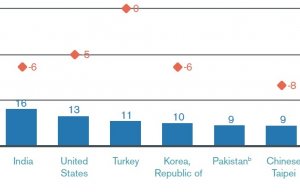
World textile and apparel exports fall in 2016
Opinion


Faster, more automated process techniques are being urgently demanded, as well as more options for recycling, Adrian Wilson reports.

14th March 2016
Adrian Wilson
|
Paris
As carbon fibre-based composites continue to make further inroads into the aerospace and automotive industries, faster, more automated process techniques are being urgently demanded, as well as more options for recycling.
These priorities were both very evident at JEC World – formerly JEC Europe – held in Paris last week from March 8-10.

The benchmark for what could be possible in automotive, for example, has been BMW’s ambitious i Series programme of new, carbon-bodied based vehicles. During JEC World, BMW’s vehicle project concept manager Stephan Huber explained how the company is going further in closing the loop in this programme across the value chain – from carbon precursor to finished car component, but just as significantly, in terms of second life usage.
BMW has now developed a range of secondary uses for its production waste carbon fibre, in the forms of granulates to replace glass fibres where possible and nonwoven fabrics for flat surfaces. Its combination of secondary carbon fibres sourced from i Series programme production with polyamide 6 is already to be found in the new JEC World Award-winning centre console for the Mini Clubman, but this is seen as only the start. Other components envisaged include intake silencers, engine covers, clutch pedals, load floors and package trays.

“We are now moving towards making carbon fibre a common material in the automotive industry,” said Huber, “but further developments are needed to boost optimum utilisation.”
BMW’s latest high performance 7 Series body, meanwhile, is without doubt the most carefully-engineered combination of material structures to date, and a number are carbon-based , pushingthe replacement of steel to new levels. The structure was also rightfully recognised at the JEC World 2016 Innovation Awards.
The modest ‘Innovation Corner’ of previous years at JEC Europe held at the Porte De Versailles Exhibition Centre gave way in 2016 to four huge display ‘planets’, separately devoted to aerospace, automotive, sports and sustainable developments at the new Parc des Expositions venue for the show.
At these, it was clear just how much is down to reducing process stages. It has been estimated that while the cost of carbon fibre processing can be further reduced by 50% in the next decade, that of actually making parts based on it can be cut by as much as 90%.

Audi AG, for example, working with a number of partners, has developed its ultra-RTM (rapid transfer moulding) process for rapidly putting together the car chassis of the latest Audi R8. Tier 1 producer Faurecia of France has developed a one-shot process for preparing woven sheets into final shapes for a number of components, and Italy’s Lamborghini is employing chopped carbon fibres in a new route to achieving A Grade surface quality in large production processes. This is just the tip of the iceberg, and doesn’t even touch on what’s also happening in aerospace or other fields.
The composites industry of 2016 is vitally important to many European manufacturers of technical textiles. A good example is the UK’s Formax, which this year becomes Hexcel UK, and as such, is part of an organisation that is responsible for supplying multiaxial knitted fabrics as the basis of parts into the latest Airbus 350 planes. Hexcel’s supply of such parts to the Airbus programme is worth $500 million per plane.

The history of Formax began with the production of terry towels and has developed over the years partially as a result of a long-standing relationship with German multiaxial knitting technology leader Karl Mayer.
“It’s been an interesting journey so far,” said Formax managing director Oliver Wesseley, “and now as part of Hexcel, there’s so much more we can achieve in the next few years.”

Business intelligence for the fibre, textiles and apparel industries: technologies, innovations, markets, investments, trade policy, sourcing, strategy...
Find out more